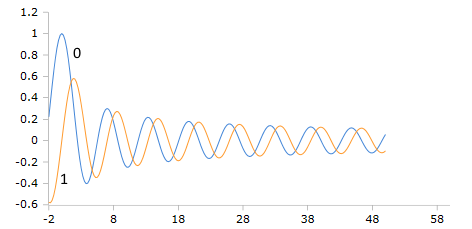Ordinary Bessel-J Function for Complex Numbers
Calculation of the Bessel function \(J_\nu(z)\) of the first kind with oscillatory behavior
Bessel-J Function Calculator
Ordinary Bessel Function \(J_\nu(z)\)
The ordinary Bessel function \(J_\nu(z)\) of the first kind exhibits oscillatory behavior and is a solution to the Bessel differential equation.
Bessel-J Properties
Behavior
Oscillatory
Decaying oscillations
Not exponentialKind
First Kind
Type: \(J_\nu\)
Regular at originOrder
ν ∈ ℝ
Any real number
Integer or rationalArgument
z ∈ ℂ
Complex: a+bi
Real and imaginary partImportant Properties
- Solution of the Bessel differential equation
- Oscillatory, decaying behavior for large |z|
- Symmetry relation: \(J_{-n}(z) = (-1)^n J_n(z)\) for integer n
- Limit: \(J_0(0) = 1\), \(J_\nu(0) = 0\) for ν > 0

Plot of the Bessel-J function with orders 0 and 1
|
|
Definition of the Ordinary Bessel Function
The ordinary Bessel function of the first kind \(J_\nu(z)\) is defined by:
Power Series Expansion
Where \(\Gamma\) is the gamma function and the factor \((-1)^m\) generates the oscillation
Bessel Differential Equation
Differential equation with solution \(w = J_\nu(z)\)
Relationship to Modified Bessel-I
Transformation to the modified Bessel function
Important Properties of the Bessel-J Function
Asymptotic Behavior
Oscillatory, decaying behavior for large |z|
Symmetry Relations
Important symmetry property of the ordinary Bessel function
Special Values
Values at the origin
Recurrence Relations
Relationships between different orders
Applications of the Bessel-J Function
Wave Mechanics
Electromagnetism
Radiation patterns
Directivity characteristics
TM and TE modes
Cutoff frequencies
Acoustics & Optics
Membrane vibrations
Slit diffraction
Interference patterns
Quantum Physics
Hydrogen atom
Cylindrically symmetric systems
Scattering problems
Eigenvalue problems
Ordinary Bessel Functions - Detailed Description
Oscillatory Behavior
The ordinary Bessel function \(J_\nu(z)\) differs fundamentally from the modified Bessel function through its oscillatory behavior.
• Oscillates for real arguments
• Decaying amplitude for large |z|
• Alternating signs in power series
• Finite at origin for ν ≥ 0
Historical Background
Friedrich Bessel introduced these functions in 1824 while studying planetary motion. They naturally arise in problems with cylindrical symmetry.
Physical Interpretation
\(J_0(kr)\) describes the amplitude of a cylindrical wave with wave number k at distance r from the axis. The zeros correspond to nodal lines.
Numerical Aspects
Unlike the modified Bessel functions, the ordinary Bessel functions are numerically more stable since they do not grow exponentially.
• Bounded values for all z
• No overflow problems
• Stable recurrence relations
• Efficient calculation algorithms
Calculation Methods
Different numerical methods are used depending on the argument range:
Medium |z|: Recurrence relations
Large |z|: Asymptotic expansions
Special values: Closed-form expressions
Special Values
Some Bessel functions have closed-form expressions, e.g.:
\(J_{1/2}(z) = \sqrt{\frac{2}{\pi z}} \sin(z)\)
\(J_{-1/2}(z) = \sqrt{\frac{2}{\pi z}} \cos(z)\)
Comparison: Bessel-J vs. Bessel-I
Ordinary Bessel-J Function
Behavior: Oscillatory, decaying
DDE: \(z^2w'' + zw' + (z^2-\nu^2)w = 0\)
Asymptotics: \(\sim \sqrt{\frac{2}{\pi z}} \cos(...)\)
Modified Bessel-I Function
Behavior: Exponentially growing
DDE: \(z^2w'' + zw' - (z^2+\nu^2)w = 0\)
Asymptotics: \(\sim \frac{e^z}{\sqrt{2\pi z}}\)
Application Guidelines
- Wave propagation: Use Bessel-J
- Vibration modes: Bessel-J for eigenvalues
- Cylindrical waves: \(J_0\) and \(J_1\) most common
- Diffusion/heat conduction: Use Bessel-I
- Exponential growth: Modified functions
- Large arguments: Pay attention to numerical stability
Bessel Functions - Complete Definitions and Relationships
Ordinary Bessel Functions
The Bessel function of the first kind of order n is defined as:
The Bessel function of the second kind (Neumann function) is:
Applications of J-Functions
Ordinary Bessel functions are fundamental for all oscillatory phenomena with cylindrical symmetry: vibrations of drumheads, electromagnetic waves in waveguides, quantum mechanics in cylindrically symmetric potentials.
Modified Bessel Functions
The modified Bessel function of the first kind is defined as:
The modified Bessel function of the second kind is:
Hankel Functions
Complex linear combinations:
\(H_\nu^{(1)}(z) = J_\nu(z) + iY_\nu(z)\)
\(H_\nu^{(2)}(z) = J_\nu(z) - iY_\nu(z)\)
Important for outgoing and incoming cylindrical waves.
|
|
|
|
More complex functions
Absolute value (abs) • Angle • Conjugate • Division • Exponent • Logarithm to base 10 • Multiplication • Natural logarithm • Polarform • Power • Root • Reciprocal • Square root •Cosh • Sinh • Tanh •
Acos • Asin • Atan • Cos • Sin • Tan •
Airy function • Derivative Airy function •
Bessel-I • Bessel-Ie • Bessel-J • Bessel-Je • Bessel-K • Bessel-Ke • Bessel-Y • Bessel-Ye •